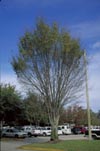Home >
Ulmus americana var. floridana,
Florida Elm
Florida Elm should be grown in full sun on well-drained, rich soil but it adapts to a wide variety of soils. Tolerant of clay, loam or sand, acid or alkaline soil, it is no wonder this tree was so popular in the early part of the century. If you plant Florida Elm, plan on implementing a monitoring program to watch for symptoms of Dutch elm disease. It is vital to the health of existing trees that a program be in place to administer special care to these disease-sensitive trees. Some selections are reported to be resistant to the Dutch Elm Disease. In areas such as Texas and Florida where elm populations are less than in northern climates, Dutch elm disease is not likely to be as big a problem as in regions with more elms.
Elms are susceptible to breakage in storms due to frequent formation of included bark in the crotches of main scaffold limbs. Follow the pruning guidelines below carefully and faithfully. Elms are among those susceptible to summer branch drop according to surveys in California. Summer branch drop is a phenomena resulting in failure and breakage of large diameter, live branches typically on calm summer days. All elms reportedly produce allergenic pollen.
Trees in their native habitat typically have one leader or trunk for several dozen feet, then trunks divide into several codominant stems toward the top of the tree. Unless properly pruned, trees in more open landscapes develop several codominant stems fairly close to the ground.
Prune to create a dominant leader by shortening aggressive main branches with reduction cuts when trees are young. It is best to prune elms only in the dormant season to help avoid the spread of Dutch elm disease in regions where this disease is a problem. Prune off and dispose of declining limbs that are infested with wood-boring insects. A regular pruning program is required on elms in order to develop good structure both in the nursery and after planting to the landscape.
The
species occurs naturally in north and central Florida south to Lake Okeechobee.
Co-national champions are 56 x 60 and 70 x 77 feet in Florida.




